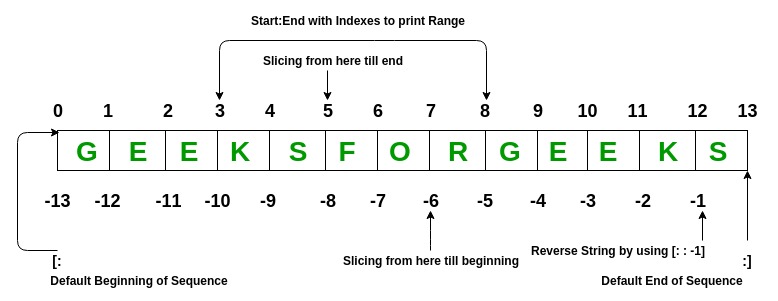An Introduction to Python Lists
List in Python are ordered and have a definite count. The elements in a list are indexed according to a definite sequence and the indexing of a list is done with 0 being the first index. Each element in the list has its definite place in the list, which allows duplicating of elements in the list, with each element having its own distinct place and credibility.
Note- Lists are a useful tool for preserving a sequence of data and further iterating over it.
Creating a List
Lists in Python can be created by just placing the sequence inside the square brackets[]. Unlike Sets, list doesn’t need a built-in function for creation of list.
Note – Unlike Sets, list may contain mutable elements.
# Python program to demonstrate
# Creation of List
# Creating a List
List = []
print("Intial blank List: ")
print(List)
# Creating a List with
# the use of a String
List = ['GeeksForGeeks']
print("\nList with the use of String: ")
print(List)
# Creating a List with
# the use of multiple values
List = ["Geeks", "For", "Geeks"]
print("\nList containing multiple values: ")
print(List[0])
print(List[2])
# Creating a Multi-Dimensional List
# (By Nesting a list inside a List)
List = [['Geeks', 'For'] , ['Geeks']]
print("\nMulti-Dimensional List: ")
print(List)
Output:
Intial blank List:
[]
List with the use of String:
['GeeksForGeeks']
List containing multiple values:
Geeks
Geeks
Multi-Dimensional List:
[['Geeks', 'For'], ['Geeks']]
Creating a list with multiple distinct or duplicate elements
A list may contain duplicate values with their distinct positions and hence, multiple distinct or duplicate values can be passed as a sequence at the time of list creation.
# Creating a List with
# the use of Numbers
# (Having duplicate values)
List = [1, 2, 4, 4, 3, 3, 3, 6, 5]
print("\nList with the use of Numbers: ")
print(List)
# Creating a List with
# mixed type of values
# (Having numbers and strings)
List = [1, 2, 'Geeks', 4, 'For', 6, 'Geeks']
print("\nList with the use of Mixed Values: ")
print(List)
Output:
List with the use of Numbers:
[1, 2, 4, 4, 3, 3, 3, 6, 5]
List with the use of Mixed Values:
[1, 2, 'Geeks', 4, 'For', 6, 'Geeks']
Adding Elements to a List
Using append() method
Elements can be added to the List by using built-in [append()](https://www.geeksforgeeks.org/list-methods-python/) function. Only one element at a time can be added to the list by using append() method, for addition of multiple elements with the append() method, loops are used. Tuples can also be added to the List with the use of append method because tuples are immutable. Unlike Sets, Lists can also be added to the existing list with the use of append() method.
# Python program to demonstrate
# Addition of elements in a List
# Creating a List
List = []
print("Initial blank List: ")
print(List)
# Addition of Elements
# in the List
List.append(1)
List.append(2)
List.append(4)
print("\nList after Addition of Three elements: ")
print(List)
# Adding elements to the List
# using Iterator
for i in range(1, 4):
List.append(i)
print("\nList after Addition of elements from 1-3: ")
print(List)
# Adding Tuples to the List
List.append((5, 6))
print("\nList after Addition of a Tuple: ")
print(List)
# Addition of List to a List
List2 = ['For', 'Geeks']
List.append(List2)
print("\nList after Addition of a List: ")
print(List)
Output:
Initial blank List:
[]
List after Addition of Three elements:
[1, 2, 4]
List after Addition of elements from 1-3:
[1, 2, 4, 1, 2, 3]
List after Addition of a Tuple:
[1, 2, 4, 1, 2, 3, (5, 6)]
List after Addition of a List:
[1, 2, 4, 1, 2, 3, (5, 6), ['For', 'Geeks']]
Using insert() method
append() method only works for addition of elements at the end of the List, for addition of element at the desired position, insert() method is used. Unlike append() which takes only one argument, insert() method requires two arguments(position, value).
# Python program to demonstrate
# Addition of elements in a List
# Creating a List
List = [1,2,3,4]
print("Initial List: ")
print(List)
# Addition of Element at
# specific Position
# (using Insert Method)
List.insert(3, 12)
List.insert(0, 'Geeks')
print("\nList after performing Insert Operation: ")
print(List)
Output:
Initial List:
[1, 2, 3, 4]
List after performing Insert Operation:
['Geeks', 1, 2, 3, 12, 4]
Using extend() method
Other than append() and insert() methods, there’s one more method for Addition of elements, **extend()**, this method is used to add multiple elements at the same time at the end of the list.
# Python program to demonstrate
# Addition of elements in a List
# Creating a List
List = [1,2,3,4]
print("Initial List: ")
print(List)
# Addition of multiple elements
# to the List at the end
# (using Extend Method)
List.extend([8, 'Geeks', 'Always'])
print("\nList after performing Extend Operation: ")
print(List)
Output:
Initial List:
[1, 2, 3, 4]
List after performing Extend Operation:
[1, 2, 3, 4, 8, 'Geeks', 'Always']
Accessing elements from the List
In order to access the list items refer to the index number.Use the index operator [ ] to access an item in a list.The index must be an integer.Nested list are accessed using nested indexing.
# Python program to demonstrate
# accessing of element from list
# Creating a List with
# the use of multiple values
List = ["Geeks", "For", "Geeks"]
# accessing a element from the
# list using index number
print("Accessing a element from the list")
print(List[0])
print(List[2])
# Creating a Multi-Dimensional List
# (By Nesting a list inside a List)
List = [['Geeks', 'For'] , ['Geeks']]
# accessing a element from the
# Multi-Dimensional List using
# index number
print("Acessing a element from a Multi-Dimensional list")
print(List[0][1])
print(List[1][0])
Output:
Accessing a element from the list
Geeks
Geeks
Acessing a element from a Multi-Dimensional list
For
Geeks
Negative indexing
In Python, negative sequence indexes represent positions from the end of the array. Instead of having to compute the offset as in List[len(List)-3], it is enough to just write List[-3]. Negative indexing means beginning from the end, -1 refers to the last item, -2 refers to the second last item etc.
List = [1, 2, 'Geeks', 4, 'For', 6, 'Geeks']
# accessing a element using
# negative indexing
print("Acessing element using negative indexing")
# print the last element of list
print(List[-1])
# print the third last element of list
print(List[-3])
Output:
Acessing element using negative indexing
Geeks
For
Removing Elements from the List
Using remove() method
Elements can be removed from the List by using built-in remove() function but an Error arises if element doesn’t exist in the set. Remove() method only removes one element at a time, to remove range of elements, iterator is used. The remove() method removes the specified item.
Note – Remove method in List will only remove the first occurrence of the searched element.
# Python program to demonstrate
# Removal of elements in a List
# Creating a List
List = [1, 2, 3, 4, 5, 6,
7, 8, 9, 10, 11, 12]
print("Intial List: ")
print(List)
# Removing elements from List
# using Remove() method
List.remove(5)
List.remove(6)
print("\nList after Removal of two elements: ")
print(List)
# Removing elements from List
# using iterator method
for i in range(1, 5):
List.remove(i)
print("\nList after Removing a range of elements: ")
print(List)
Output:
Intial List:
[1, 2, 3, 4, 5, 6, 7, 8, 9, 10, 11, 12]
List after Removal of two elements:
[1, 2, 3, 4, 7, 8, 9, 10, 11, 12]
List after Removing a range of elements:
[7, 8, 9, 10, 11, 12]
Using pop() method
Pop() function can also be used to remove and return an element from the set, but by default it removes only the last element of the set, to remove element from a specific position of the List, index of the element is passed as an argument to the pop() method.
List = [1,2,3,4,5]
# Removing element from the
# Set using the pop() method
List.pop()
print("\nList after popping an element: ")
print(List)
# Removing element at a
# specific location from the
# Set using the pop() method
List.pop(2)
print("\nList after popping a specific element: ")
print(List)
Output:
List after popping an element:
[1, 2, 3, 4]
List after popping a specific element:
[1, 2, 4]
Slicing of a List
In Python List, there are multiple ways to print the whole List with all the elements, but to print a specific range of elements from the list, we use Slice operation. Slice operation is performed on Lists with the use of colon(:). To print elements from beginning to a range use [:Index], to print elements from end use [:-Index], to print elements from specific Index till the end use [Index:], to print elements within a range, use [Start Index:End Index] and to print whole List with the use of slicing operation, use [:]. Further, to print whole List in reverse order, use [::-1].
Note – To print elements of List from rear end, use Negative Indexes.

# Python program to demonstrate
# Removal of elements in a List
# Creating a List
List = ['G','E','E','K','S','F',
'O','R','G','E','E','K','S']
print("Intial List: ")
print(List)
# Print elements of a range
# using Slice operation
Sliced_List = List[3:8]
print("\nSlicing elements in a range 3-8: ")
print(Sliced_List)
# Print elements from a
# pre-defined point to end
Sliced_List = List[5:]
print("\nElements sliced from 5th "
"element till the end: ")
print(Sliced_List)
# Printing elements from
# beginning till end
Sliced_List = List[:]
print("\nPrinting all elements using slice operation: ")
print(Sliced_List)
Output:
Intial List:
['G', 'E', 'E', 'K', 'S', 'F', 'O', 'R', 'G', 'E', 'E', 'K', 'S']
Slicing elements in a range 3-8:
['K', 'S', 'F', 'O', 'R']
Elements sliced from 5th element till the end:
['F', 'O', 'R', 'G', 'E', 'E', 'K', 'S']
Printing all elements using slice operation:
['G', 'E', 'E', 'K', 'S', 'F', 'O', 'R', 'G', 'E', 'E', 'K', 'S']
Negative index List slicing
# Creating a List
List = ['G','E','E','K','S','F',
'O','R','G','E','E','K','S']
print("Initial List: ")
print(List)
# Print elements from beginning
# to a pre-defined point using Slice
Sliced_List = List[:-6]
print("\nElements sliced till 6th element from last: ")
print(Sliced_List)
# Print elements of a range
# using negative index List slicing
Sliced_List = List[-6:-1]
print("\nElements sliced from index -6 to -1")
print(Sliced_List)
# Printing elements in reverse
# using Slice operation
Sliced_List = List[::-1]
print("\nPrinting List in reverse: ")
print(Sliced_List)
Output:
Initial List:
['G', 'E', 'E', 'K', 'S', 'F', 'O', 'R', 'G', 'E', 'E', 'K', 'S']
Elements sliced till 6th element from last:
['G', 'E', 'E', 'K', 'S', 'F', 'O']
Elements sliced from index -6 to -1
['R', 'G', 'E', 'E', 'K']
Printing List in reverse:
['S', 'K', 'E', 'E', 'G', 'R', 'O', 'F', 'S', 'K', 'E', 'E', 'G']
#python
